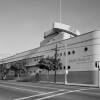Architecture and Design Museum Closes Physical Exhibition Space

Dedicated to the appreciation of the urban landscape of Los Angeles and beyond, the Architecture and Design Museum recently announced that it's giving up its brick-and-mortar location in downtown's Arts District in order to focus more on online and temporary pop-up-style exhibitions. While the effects of COVID-19 spurred the shift, plans to move to a mostly- online model were already being developed by the museum's Beyond Walls Strategic Planning Committee with hopes of reaching more people through short-lived community exhibitions and digital technology — something that's evolved considerably since the museum first launched in 2001.
"A+D Museum’s mission to be a platform and space of engagement for our architects, designers, creatives and audience must shift with the needs of our community," reads a June 17 post from the museum's Instagram account. "As a team we have heard the response to societal shifts, and as a family we recognize the opportunity to transform ourselves in response to this place in time."

Third-generation L.A. architect Stephen Kanner (1955-2010) co-founded the museum in order to celebrate "the advantages and benefits of modernism and sustainability and diverse materials," according to a 2006 interview with Curbed LA. In the interview, Kanner explained that the museum's goal was to "focus on contemporary design and planning" through a series of exhibits spanning all levels of expertise, from students to master architects. "We are such a young country, and L.A. is even younger as a cultural center, that we still are acquiring our appreciation for architecture and its history," Kanner said.

Throughout his own career, Kanner was highly influential in guiding L.A.'s design aesthetic. As a founding member of the Westwood Design Review Board, he was instrumental in maintaining the neighborhood's historical integrity. A consistent champion of uplifting, progressive architecture, he was a big believer in the idea that L.A.'s look is influenced by transportation, something that's visible in his colorful Metro Hollywood Transit Village at Hollywood and Western. Kanner also supported the use of environmentally-friendly building practices in favor of less sustainable and outmoded ones, having converted a neglected commercial space into the Sunset Vine Tower luxury Hollywood apartment building. "We have always believed in sustainability and use of renewable materials and are grateful that more and more architects are increasingly incorporating green and sustainable features," Kramer told Curbed LA.
With an eye towards sustainability and the celebration of great architecture, it made sense that the A+D Museum's first location was inside the late 19th-century Bradbury Building, a National Historic Landmark that's provided a backdrop for films such as “Chinatown” (1974), “Blade Runner” (1982) and “Lethal Weapon 4” (1998), to name a few. After leaving the Bradbury Building, the A+D Museum relocated to a space in West Hollywood before moving to 5900 Wilshire, a 32-story skyscraper located across the street from LACMA. From there, it traveled two blocks east next to the Petersen Automotive Museum, where it remained before relocating to its final physical location downtown at 900 East 4th Street. Now, for the first time, the nonprofit institution will be without a real-life space for the public to visit.
"As an organization we are adopting a network format which allows us to go beyond and bring our appreciation for local makers to a global scale," explains the A+D Museum. "Our goal is to become a more expansive museum which adapts to the hybridized structure society is demanding today. This shift will allow the museum to focus all its resources more purely on its values beyond the limitations of a building."

The museum will not only bring future projects online, but also to various U.S. cities through what the museum calls "short-term community-driven physical exhibitions and events" — all with the goal of "reaching a wider, increasingly inclusive audience and engaging new communities," according to the museum's website. Speaking to the Los Angeles Times, A+D Museum's Executive Director Anthony Morey elaborated: “The world of creation, collaboration and experimentation was, for a long time, defined by a physical presence, sitting at a table working together and being present. Over the last five or 10 years, working digitally and from other locations have slowly been taking hold — and reaffirmed by the circumstances we now find ourselves in.” (Morey also told the Times that everyone on the museum's staff will keep their jobs during the latest transition, with another even joining the team.)

It may seem ironic that an organization devoted exclusively to architecture should now have no physical space of its own. After all, architecture is a practice that provides people with a physical environment in which to live. But it's also one that looks toward the future, taking into consideration various factors such as adaptability, scalability, flexibility, growth and eventual decay. By addressing the needs of the community and moving the bulk of its exhibitions online, the A+D Museum has shown that today's public doesn't need a real-life venue that’s dedicated to the appreciation of architecture: it just needs the architecture itself.
Top Image: An exhibition opening scene at A+D Museum in 2010. | Carren Jao








